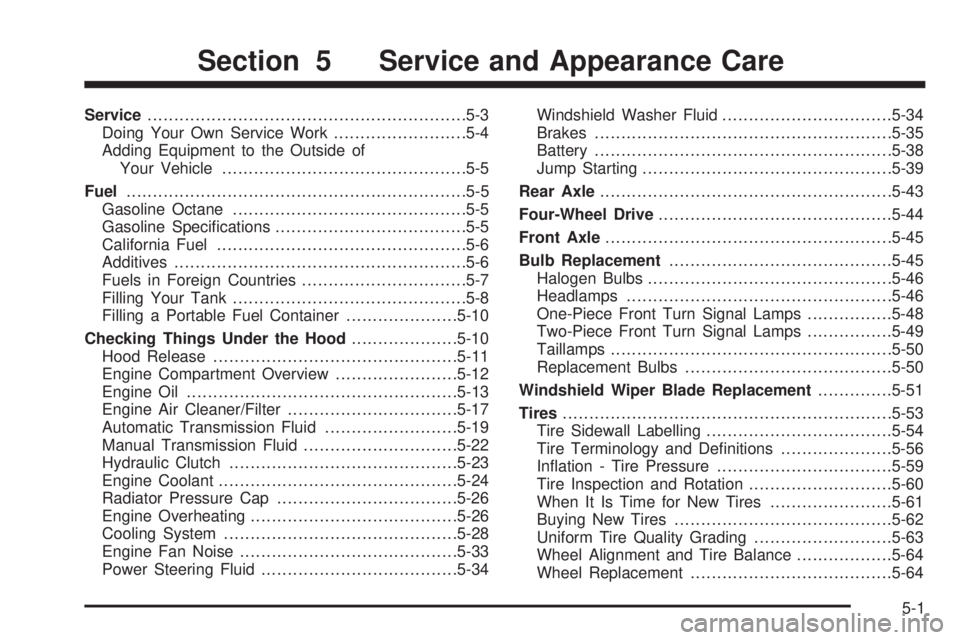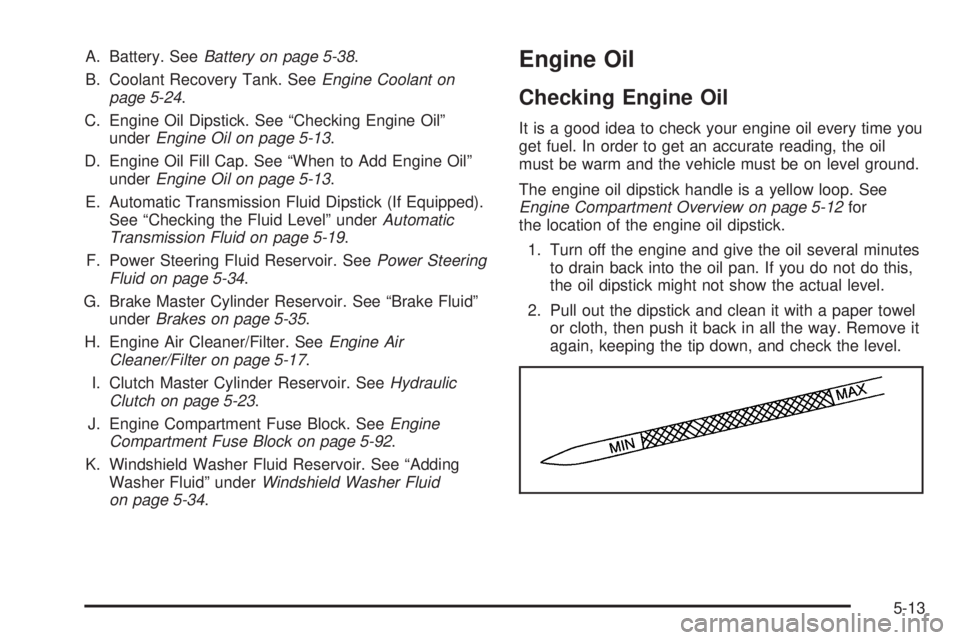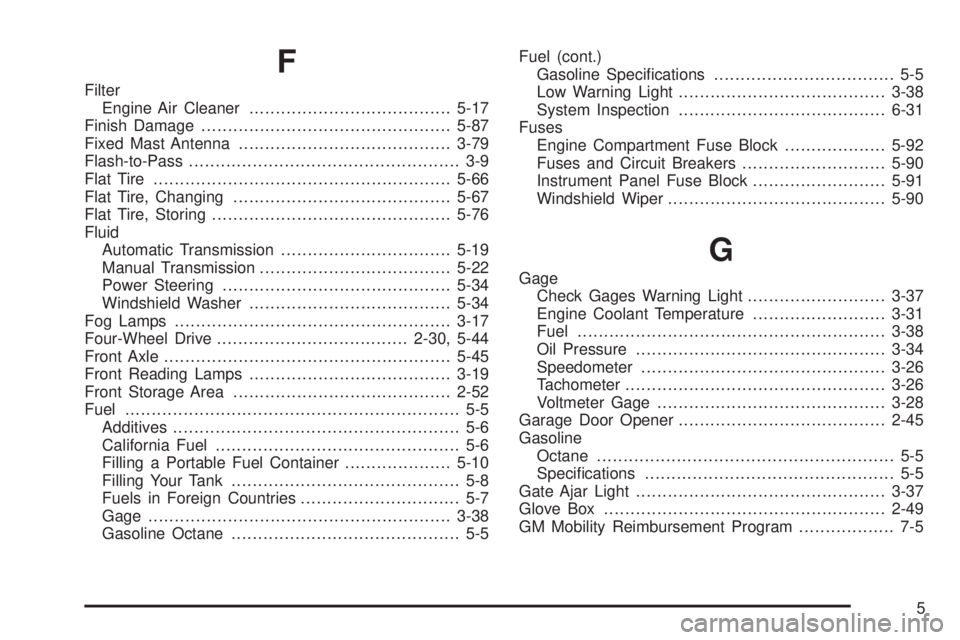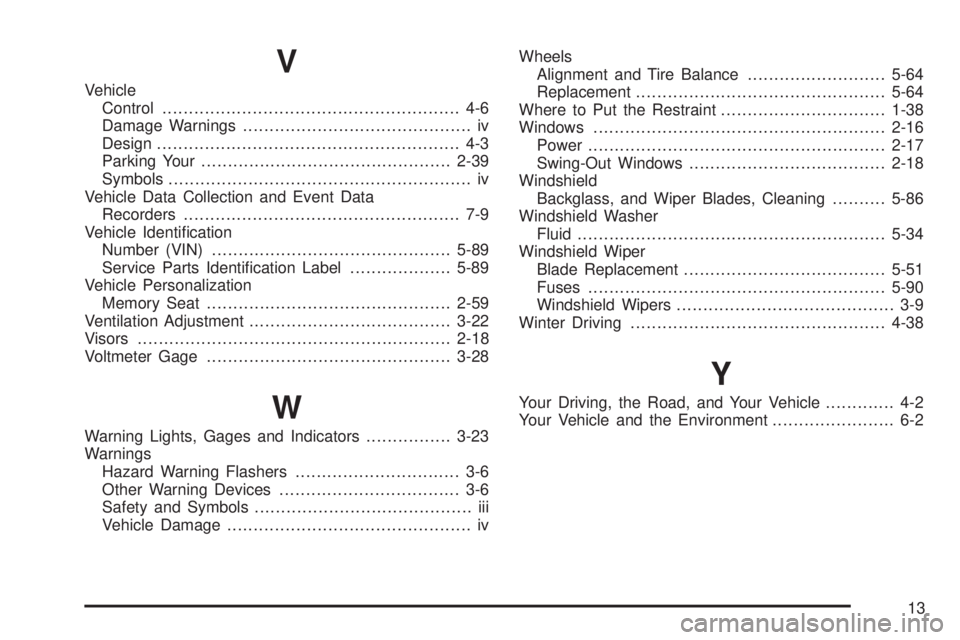5-34 GMC JIMMY 2005 Owner's Manual
[x] Cancel search | Manufacturer: GMC, Model Year: 2005, Model line: JIMMY, Model: GMC JIMMY 2005Pages: 432, PDF Size: 2.65 MB
Page 273 of 432

Service............................................................5-3
Doing Your Own Service Work.........................5-4
Adding Equipment to the Outside of
Your Vehicle..............................................5-5
Fuel................................................................5-5
Gasoline Octane............................................5-5
Gasoline Speci�cations....................................5-5
California Fuel...............................................5-6
Additives.......................................................5-6
Fuels in Foreign Countries...............................5-7
Filling Your Tank............................................5-8
Filling a Portable Fuel Container.....................5-10
Checking Things Under the Hood....................5-10
Hood Release..............................................5-11
Engine Compartment Overview.......................5-12
Engine Oil...................................................5-13
Engine Air Cleaner/Filter................................5-17
Automatic Transmission Fluid.........................5-19
Manual Transmission Fluid.............................5-22
Hydraulic Clutch...........................................5-23
Engine Coolant.............................................5-24
Radiator Pressure Cap..................................5-26
Engine Overheating.......................................5-26
Cooling System............................................5-28
Engine Fan Noise.........................................5-33
Power Steering Fluid.....................................5-34Windshield Washer Fluid................................5-34
Brakes........................................................5-35
Battery........................................................5-38
Jump Starting...............................................5-39
Rear Axle.......................................................5-43
Four-Wheel Drive............................................5-44
Front Axle......................................................5-45
Bulb Replacement..........................................5-45
Halogen Bulbs..............................................5-46
Headlamps..................................................5-46
One-Piece Front Turn Signal Lamps................5-48
Two-Piece Front Turn Signal Lamps................5-49
Taillamps.....................................................5-50
Replacement Bulbs.......................................5-50
Windshield Wiper Blade Replacement..............5-51
Tires..............................................................5-53
Tire Sidewall Labelling...................................5-54
Tire Terminology and De�nitions.....................5-56
In�ation - Tire Pressure.................................5-59
Tire Inspection and Rotation...........................5-60
When It Is Time for New Tires.......................5-61
Buying New Tires.........................................5-62
Uniform Tire Quality Grading..........................5-63
Wheel Alignment and Tire Balance..................5-64
Wheel Replacement......................................5-64
Section 5 Service and Appearance Care
5-1
Page 285 of 432

A. Battery. SeeBattery on page 5-38.
B. Coolant Recovery Tank. SeeEngine Coolant on
page 5-24.
C. Engine Oil Dipstick. See “Checking Engine Oil”
underEngine Oil on page 5-13.
D. Engine Oil Fill Cap. See “When to Add Engine Oil”
underEngine Oil on page 5-13.
E. Automatic Transmission Fluid Dipstick (If Equipped).
See “Checking the Fluid Level” underAutomatic
Transmission Fluid on page 5-19.
F. Power Steering Fluid Reservoir. SeePower Steering
Fluid on page 5-34.
G. Brake Master Cylinder Reservoir. See “Brake Fluid”
underBrakes on page 5-35.
H. Engine Air Cleaner/Filter. SeeEngine Air
Cleaner/Filter on page 5-17.
I. Clutch Master Cylinder Reservoir. SeeHydraulic
Clutch on page 5-23.
J. Engine Compartment Fuse Block. SeeEngine
Compartment Fuse Block on page 5-92.
K. Windshield Washer Fluid Reservoir. See “Adding
Washer Fluid” underWindshield Washer Fluid
on page 5-34.Engine Oil
Checking Engine Oil
It is a good idea to check your engine oil every time you
get fuel. In order to get an accurate reading, the oil
must be warm and the vehicle must be on level ground.
The engine oil dipstick handle is a yellow loop. See
Engine Compartment Overview on page 5-12for
the location of the engine oil dipstick.
1. Turn off the engine and give the oil several minutes
to drain back into the oil pan. If you do not do this,
the oil dipstick might not show the actual level.
2. Pull out the dipstick and clean it with a paper towel
or cloth, then push it back in all the way. Remove it
again, keeping the tip down, and check the level.
5-13
Page 306 of 432

Power Steering Fluid
The power steering
reservoir is located near
the front of the engine
compartment on the
driver’s side of the vehicle.
SeeEngine Compartment
Overview on page 5-12
for reservoir location.
When to Check Power Steering Fluid
It is not necessary to regularly check power steering �uid
unless you suspect there is a leak in the system or
you hear an unusual noise. A �uid loss in this system
could indicate a problem. Have the system inspected
and repaired.
How to Check Power Steering Fluid
To check the power steering �uid, do the following:
1. Turn the key off and let the engine compartment
cool down.
2. Wipe the cap and the top of the reservoir clean.3. Unscrew the cap and wipe the dipstick with
a clean rag.
4. Replace the cap and completely tighten it.
5. Then remove the cap again and look at the �uid
level on the dipstick.
The level should be between the ADD and FULL marks.
If necessary, add only enough �uid to bring the level
up to the proper range.
What to Use
To determine what kind of �uid to use, seePart D:
Recommended Fluids and Lubricants on page 6-33.
Always use the proper �uid. Failure to use the proper
�uid can cause leaks and damage hoses and seals.
Windshield Washer Fluid
What to Use
When you need windshield washer �uid, be sure to read
the manufacturer’s instructions before use. If you will
be operating your vehicle in an area where the
temperature may fall below freezing, use a �uid that has
sufficient protection against freezing.
5-34
Page 394 of 432

Part B: Owner Checks and Services
Listed in this part are owner checks and services
which should be performed at the intervals speci�ed to
help ensure the safety, dependability and emission
control performance of your vehicle.
Be sure any necessary repairs are completed at once.
Whenever any �uids or lubricants are added to your
vehicle, make sure they are the proper ones, as shown
in Part D.
At Each Fuel Fill
It is important for you or a service station attendant to
perform these underhood checks at each fuel �ll.
Engine Oil Level Check
Check the engine oil level and add the proper
oil if necessary. SeeEngine Oil on page 5-13for
further details.
Engine Coolant Level Check
Check the engine coolant level and add DEX-COOL®
coolant mixture if necessary. SeeEngine Coolant
on page 5-24for further details.
Windshield Washer Fluid Level Check
Check the windshield washer �uid level in the
windshield washer tank and add the proper �uid if
necessary. SeeWindshield Washer Fluid on page 5-34
for further details.
At Least Once a Month
Tire In�ation Check
Visually inspect your tires and make sure tires
are in�ated to the correct pressures. Do not forget to
check your spare tire. SeeTires on page 5-53for
further details.
Cassette Tape Player Service
Clean cassette tape player. Cleaning should be done
every 50 hours of tape play. SeeAudio System(s)
on page 3-41for further details.
6-26
Page 423 of 432

F
Filter
Engine Air Cleaner......................................5-17
Finish Damage...............................................5-87
Fixed Mast Antenna........................................3-79
Flash-to-Pass................................................... 3-9
Flat Tire........................................................5-66
Flat Tire, Changing.........................................5-67
Flat Tire, Storing.............................................5-76
Fluid
Automatic Transmission................................5-19
Manual Transmission....................................5-22
Power Steering...........................................5-34
Windshield Washer......................................5-34
Fog Lamps....................................................3-17
Four-Wheel Drive....................................2-30, 5-44
Front Axle......................................................5-45
Front Reading Lamps......................................3-19
Front Storage Area.........................................2-52
Fuel............................................................... 5-5
Additives...................................................... 5-6
California Fuel.............................................. 5-6
Filling a Portable Fuel Container....................5-10
Filling Your Tank........................................... 5-8
Fuels in Foreign Countries.............................. 5-7
Gage.........................................................3-38
Gasoline Octane........................................... 5-5Fuel (cont.)
Gasoline Speci�cations.................................. 5-5
Low Warning Light.......................................3-38
System Inspection.......................................6-31
Fuses
Engine Compartment Fuse Block...................5-92
Fuses and Circuit Breakers...........................5-90
Instrument Panel Fuse Block.........................5-91
Windshield Wiper.........................................5-90
G
Gage
Check Gages Warning Light..........................3-37
Engine Coolant Temperature.........................3-31
Fuel..........................................................3-38
Oil Pressure...............................................3-34
Speedometer..............................................3-26
Tachometer.................................................3-26
Voltmeter Gage...........................................3-28
Garage Door Opener.......................................2-45
Gasoline
Octane........................................................ 5-5
Speci�cations............................................... 5-5
Gate Ajar Light...............................................3-37
Glove Box.....................................................2-49
GM Mobility Reimbursement Program.................. 7-5
5
Page 427 of 432

Outside (cont.)
Heated Mirrors............................................2-44
Manual Mirror.............................................2-43
Power Mirrors.............................................2-43
Overhead Console..........................................2-49
Owners, Canadian............................................... ii
P
Park (P)
Shifting Into................................................2-37
Shifting Out of............................................2-39
Parking
Brake........................................................2-36
Over Things That Burn.................................2-40
Parking Your Vehicle.......................................2-39
Part A - Scheduled Maintenance Services............ 6-4
Part B - Owner Checks and Services................6-26
Part C - Periodic Maintenance Inspections..........6-31
Part D - Recommended Fluids and Lubricants....6-33
Part E - Maintenance Record...........................6-36
Passing.........................................................4-12
Passlock
®......................................................2-20
Power
Door Locks.................................................. 2-9
Electrical System.........................................5-90
Lumbar Controls........................................... 1-3
Retained Accessory (RAP)............................2-23
Seat............................................................ 1-3Power (cont.)
Steering Fluid.............................................5-34
Windows....................................................2-17
Programmable Automatic Door Locks.................. 2-9
Programming the HomeLink
®Transmitter...........2-46
Q
Questions and Answers About Safety Belts.........1-12
R
Radiator Pressure Cap....................................5-26
Radios..........................................................3-41
AM-FM Radio.............................................3-43
Care of Your Cassette Tape Player................3-78
Care of Your CD Player...............................3-79
Care of Your CDs........................................3-79
Radio with Cassette and CD.........................3-54
Radio with CD............................................3-46
Radio with Six-Disc CD................................3-67
Setting the Time for Radios with Radio
Data Systems (RDS)................................3-42
Setting the Time for Radios without
Radio Data Systems (RDS).......................3-42
Theft-Deterrent............................................3-77
Understanding Reception..............................3-78
Rear Axle......................................................5-43
Rear Door Security Locks................................2-11
9
Page 431 of 432

V
Vehicle
Control........................................................ 4-6
Damage Warnings........................................... iv
Design......................................................... 4-3
Parking Your...............................................2-39
Symbols......................................................... iv
Vehicle Data Collection and Event Data
Recorders.................................................... 7-9
Vehicle Identi�cation
Number (VIN).............................................5-89
Service Parts Identi�cation Label...................5-89
Vehicle Personalization
Memory Seat..............................................2-59
Ventilation Adjustment......................................3-22
Visors...........................................................2-18
Voltmeter Gage..............................................3-28
W
Warning Lights, Gages and Indicators................3-23
Warnings
Hazard Warning Flashers............................... 3-6
Other Warning Devices.................................. 3-6
Safety and Symbols......................................... iii
Vehicle Damage.............................................. ivWheels
Alignment and Tire Balance..........................5-64
Replacement...............................................5-64
Where to Put the Restraint...............................1-38
Windows.......................................................2-16
Power........................................................2-17
Swing-Out Windows.....................................2-18
Windshield
Backglass, and Wiper Blades, Cleaning..........5-86
Windshield Washer
Fluid..........................................................5-34
Windshield Wiper
Blade Replacement......................................5-51
Fuses........................................................5-90
Windshield Wipers......................................... 3-9
Winter Driving................................................4-38
Y
Your Driving, the Road, and Your Vehicle............. 4-2
Your Vehicle and the Environment....................... 6-2
13